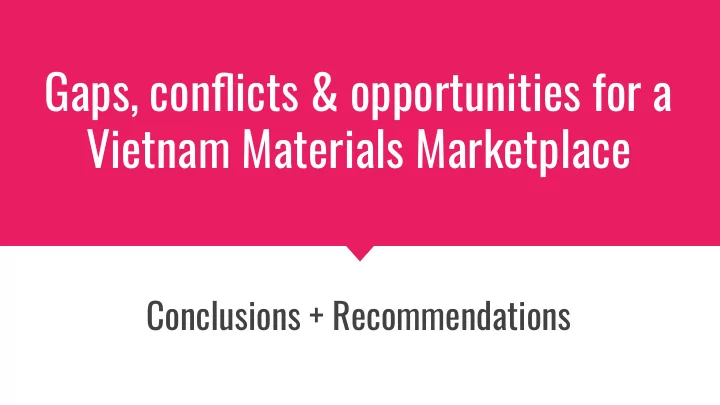

Gaps, conflicts & opportunities for a Vietnam Materials Marketplace Conclusions + Recommendations
Research on materials flows in Vietnam Study goals: 1. Review the country’s regulatory framework and how it could affect deployment of a circular economy model in the plastic and paper industries. 2. Assess the willingness of stakeholders to participate in a circular economy materials marketplace program, including buyers and sellers of recycled plastic and paper materials and supporting service providers. 3. Establish an initial database of buyers, sellers and supporting service providers for further development on a secondary materials market of the two industrial sectors. (identify players & identify initial locations) 4. Establish a high-level public-private sector project advisory committee
Situation Summary Opportunity: Boost manufacturing Challenge: Current policies and growth by tapping into recycled and practices conflict or are reusable materials while decreasing under-developed; there is a lack the environmental impact (Circular of common understanding and tools. Economy). Stakeholders desire to: This will require: Place to start: Recommend Phase 1 Recommend Phase 2 Increase recycling & Improvements to Programs and systems Establish an oversight Implement material reuse while decreasing regulations and for gathering and sharing committee to make & test trading platform (VMM) pollution enforcement policies, material flow data should policies, incentives and process & equipment be implemented; penalties Start innovation center or investment, market data transparency will align all zones fueled by material transparency stakeholders on same set Implement platform data, social engagement of data (VMM) to track material and internal/external data & transactions investment
Focus study on Vietnam material flow of plastic & paper Desk research, surveyed 312 producers, consumers, service providers, agencies, NGOs; 11 in-person interviews Current practices create market conflicts: Mfg production is rising, 14.4% growth in 74% of those surveyed were positive 2017 Make imported scrap more attractive about a marketplace (cost & quality) than domestic yet Domestic plastic materials (primary and constrict access to it 37% expressed immediate interest in recycled) meet only 20% of the demand engaging Develop strong regulations yet practice 3M tons of plastic flow into the weak enforcement, ofger few incentives & Comments shed light on desire for environment annually; 730,000 tons into fund little outreach, education and fair-play, ability to connect to other users, the ocean promotion need for transaction and standardized material classification tools Motivates and enables illegal operation
Hurdles to overcome Domestic supplies of paper and plastics are falling dramatically short of ● meeting the needs of the Vietnamese private sector and this gap is projected to grow as the economy grows; Recently established regulations aimed at preventing the import of waste ● streams have had the unintended consequence of blocking needed scrap materials from reaching manufacturers; Increasing domestic production of reusable material will require ● investment for increased processing efficiency; need capability to connect supply & demand to facilitate business case development; Solution requires structured collaboration of industry, NGOs, government ● and investors; challenging to align interests and action; high-level advisory committee established chaired by VCCI
Priority marketplace deliverables, validated by study Standardize location and language on material volumes, content & quality ● Systematic data collection of material inputs and outputs to/from industry ● & waste service providers; Potential system for tracking and tracing material imports ● Ability to consolidate marketing, promotional & educational outreach ● Real-time conversation & transaction tool ● Certification of compliant market participants; curated directory ● Access by governmental authorities, industry associations and NGOs to data ● on material flows; transparency in analytics and reporting tools Ability to implement fee and collection for self-sustaining operation ● Local program & platform management; environment where industry and ● government can collaborate (led by VCCI)
Support for Vietnam materials marketplace In June 2019, the Vietnam Communist Party asked government ministries to work with key industry organizations, led by the Vietnam Chamber of Commerce and Industry, to establish a long-term national strategy to establish a circular economy in Vietnam. In limited initial interviews, key organizations & companies expressed support for platform to provide greater data transparency, regulatory rationalization and modernization of recycling and waste infrastructure and services. Support includes: VN Pulp & Paper Assoc, Lee & Mann Paper Mfg, DOW, Coca Cola, VN Plastics Assoc, World Wildlife Fund - VN, Nike, JP Corolex
Phase 1 execution targets 1. Establish marketplace management committee with public / private partnership a. Led by VCCI as bridge organization between government, industry and NGOs b. Important government stakeholders (MONRE, MOIT, Customs, MOST, MPI…), provincial representatives c. Include key industry organizations, VPA and VPPA, as well as representatives from active environmental NGOs such as WWF and GreenHub 2. Select Vietnam technology partner to manage localization and customization of platform 3. Establish participant certification process
Phase 1 execution targets 4. Focus regions: Ho Chi Minh city, Dong Nai, Binh Duong, Hanoi, Hai Phong, Hung Yen, Long An, Bac Ninh, Phu Tho and Thanh Hoa 5. Target user sizes: Large to medium; 5000 tons of plastic per year; 50,000 tons of paper 6. Prioritized infrastructure investments: Manufacturing of recycled plastic resin, domestic paper sorting 7. Plastic waste mgmt needs more attention than paper; according to MONRE, 12.4% of landfill content is plastic waste vs 5% for paper (rough estimates only -- little data exists, especially for industry)
Imported material made more attractive; but increasingly harder to get (legally) Transaction documentation needed for VAT deduction; easy to get with imports, not easy to get with domestic transactions --- this makes price of imported material more competitive. Inspections required for imports, not for domestic. So, quality of legally imported material is more known and consistent. Regulations coming that more tightly control types of imported material, who can use it, who can import it -- complicating sourcing MONRE and MOIT overlap with needed approval at customs; causes large delays
How this can benefit smaller craft villages (Phase 2) Recycling is rudimentary and dominated by the informal sector, causing substantial environmental problems in the craft villages where recycling takes place. Significant illegal discharge of waste due to low public awareness
Recommend
More recommend